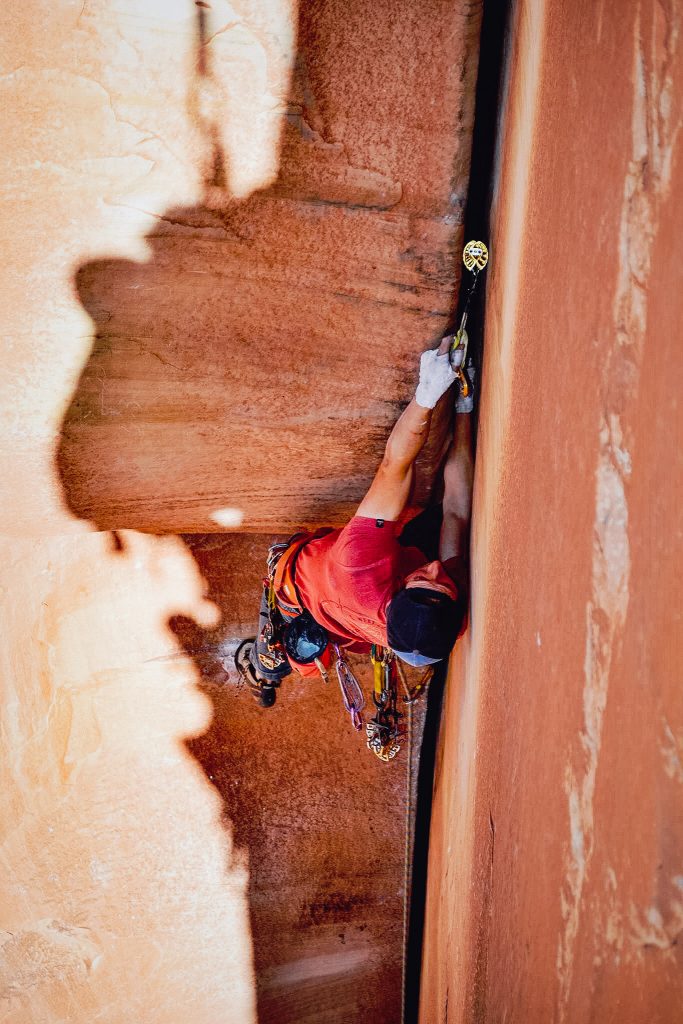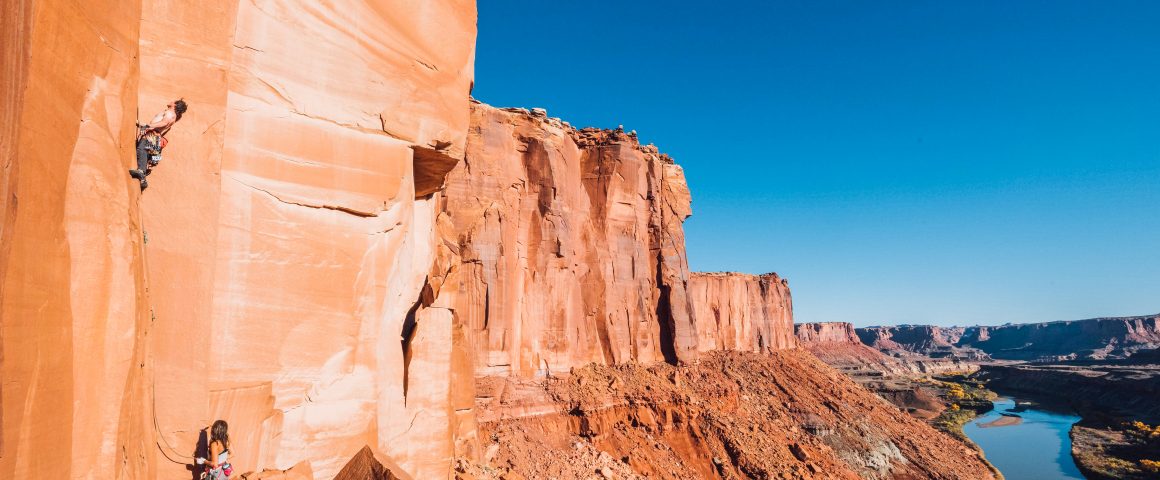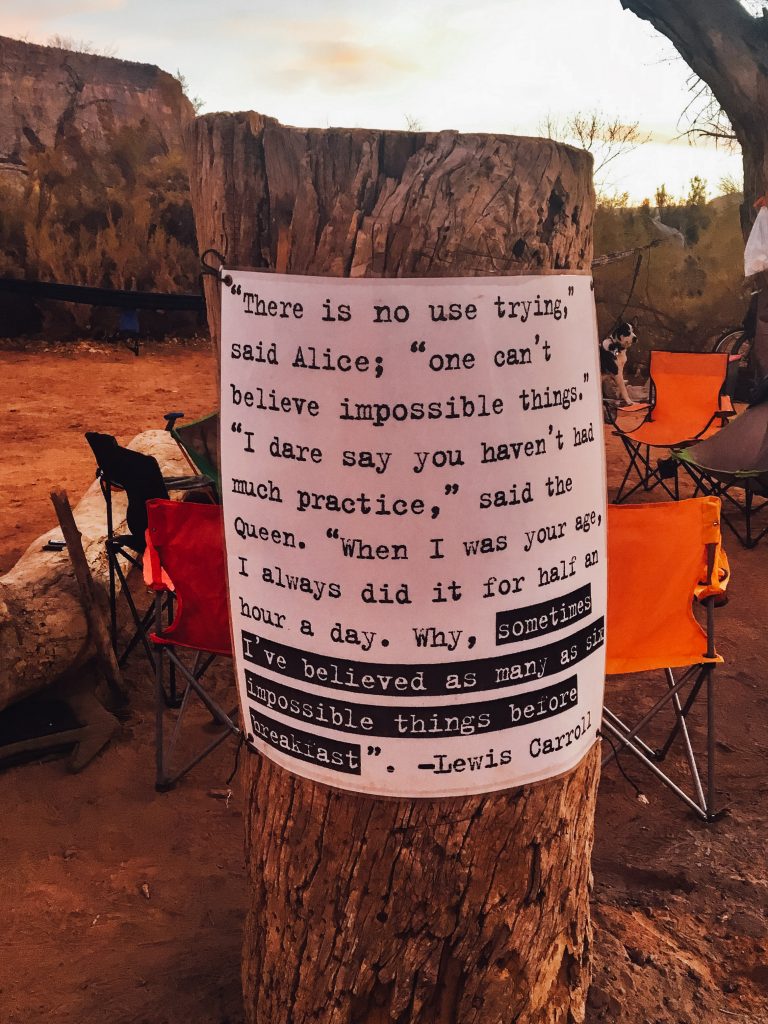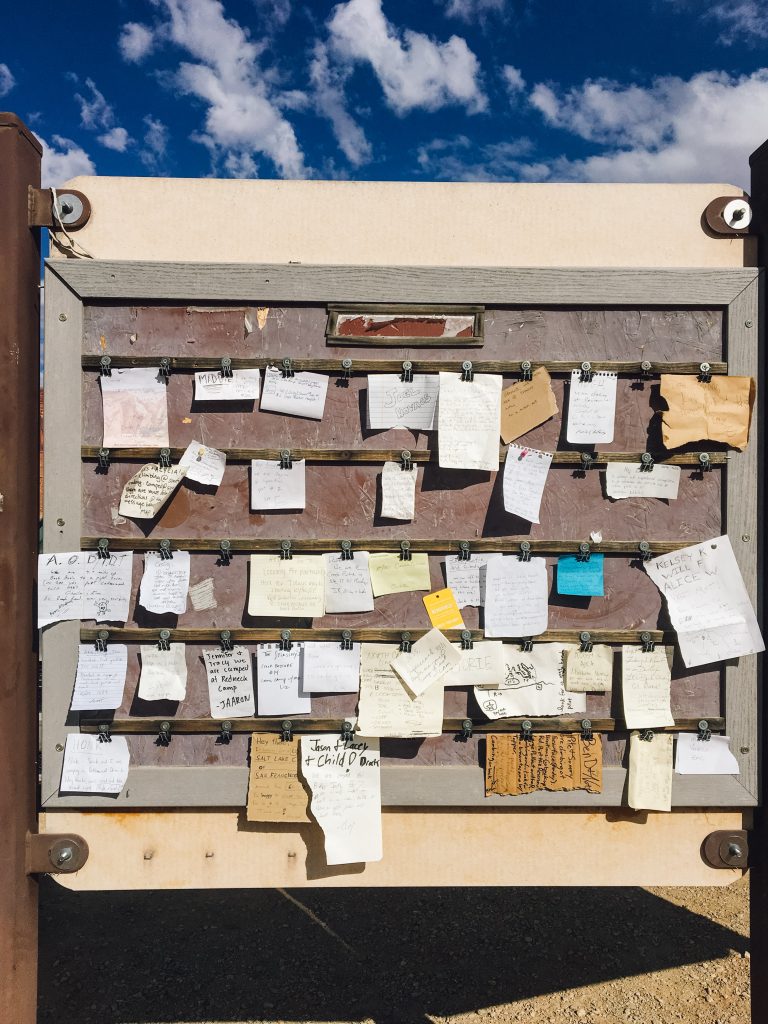By Angus Taylor
It was happening. I’d finally scrounged together enough pennies to find myself on a plane to the states. I had one mission: Get to Yosemite. Which is the one thing that did not end up happening. What happened instead was the last thing I had expected: I fell in love with the desert.
I had been dreaming of the valley stone, the scent of pine, and watching last light high up on shimmering granite faces, but first I had a pit stop to make. I needed to pick up the one thing climbers with this sort of trip in mind rely on almost entirely. Rope. My solution to avoid carting three ropes from the ‘land down under’ to the US was simple and certainly cheaper. Buy the ropes I needed in the US and have them posted to a friend. Trouble was, the aforementioned friend was currently living in Moab, Utah, which isn’t exactly a stone’s throw from the valley. It did, however, happen to be the nearest major town to Indian Creek. There were no two ways about it. So, the plan was to pick the ropes up, do a brief stint in the desert, and double back to the ‘real’ business. I was to be an iron filing to the High Sierra’s great magnet. El Capitan.
Nine-and-a-half hours into the drive from San Francisco it just so happened there was a roadblock, and one without any metaphorical connotations. Trucks lined the sides of the highway for miles; they weren’t letting anyone through due to a chemical spill on the highway. Defeated, I pulled into a parking lot nearby in an attempt to get some sleep‒but this was no use at all. I had just eaten an entire bag of snakes like an over-excited kid at a birthday party. That bag of snakes turned me into the kid at the end of the party who is running away from all the adults screaming like a broken tin whistle to the tune of “I don’t wanna go home!” I didn’t want to go to sleep. I wanted to get to Indian Creek. There was only one thing left to do.
Peaking on sugar, I coasted my van towards the police blockade and wound down the window:
“G’ day officer.”
“You’re Australian?” He must have picked up on something.
“Is there any other way around to get back on the highway?” I asked.
“Unfortunately, this is it, pal. You’ll have to pull up for the night.”
A brief moment of desperation overwhelmed me. I cleared my throat, in disbelief of what I wanted to say, but it just came blurting out anyway. “Officer, I have a funeral to get to by tomorrow in Moab, and I’ve flown over specially to get to it…” The guilt immediately washed over me. But I was too deep, I had to keep up the act. I mean, I couldn’t exactly laugh and say, “Just kidding mate, gotcha there didn’t I?”. So, I went on, like Keanu Reeves pretending to be a surfer in Point Break. Agonisingly.
“A family member is it?” He asked.
“…Yes, my aunt actually.” I almost choked on my words.
“One-second young man.” The police officer walked away and I could see him chatting on his radio.
He came back a few long moments later and said, “Son, this is quite the special circumstance. I’m going to let you through, you can re-join the highway with a three-hour detour. You have to tell the next five blockades that it was on my order to let you through ok?” After staring for a long moment, desperately trying to mask disbelief with a smarmy half-smile and an over the top nod I said, “Ok. Thank you, officer!”
To the astonishment and visible outrage of a dozen truck drivers, they opened the blockade and let me drive through. I couldn’t believe it, and not surprisingly neither could the next five blockades. By the last guy, however, as much as I’m not proud of this, I had the spiel down to a B-grade film award for best supporting actor. I was through. I’d done it. Hang me at the gallows, but by the following morning, I would be climbing.
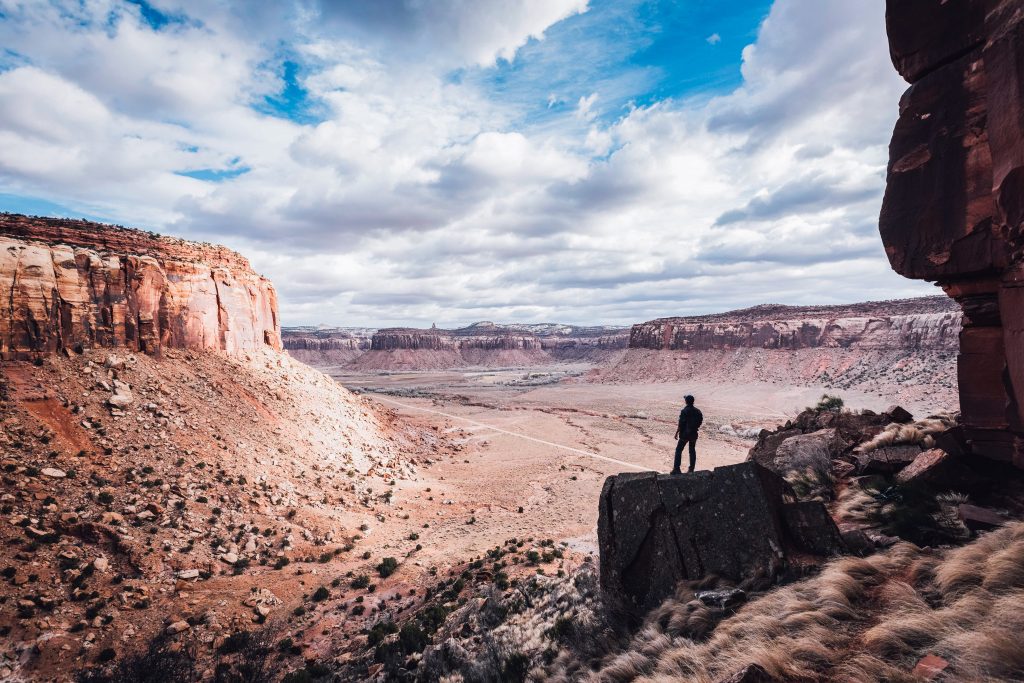
The Utah desert seemed like a place I couldn’t quite imagine with any sense of reality. Growing up as a kid in Australia watching classic westerns made the landscape seem like a make-believe backdrop that people stood in front of. Our oversized island drifting in the middle of the Pacific, made the American Southwest feel so far removed it became a fantasy. As my 15-hour drive was coming to a close, the truth slowly revealed itself to me.
The sun came up just as I was nearing Moab. At first, everything was inky, light still only managing to form a thin lip on the horizon. As the sun floated higher, it was as if in anticipation of the heavy curtain lifting at the opening of a Broadway musical. When it finally spilt into the world, my jaw hung open. What remained was an unending colosseum of glowing orange rock. Ridges crowned with sandcastle spires frozen in time, and jigsaw canyon walls that cut out into the horizon as if made by some great cookie cutter. The feeling is something I haven’t been able to find the words for since, but in comparison, the movies and photos were much like Plato’s famous cave allegory; shadows on the back wall of a cave. The reality was perplexing. I stopped the van, got out, and watched the sun chase the rest of the shadows away.
“Maybe it was laziness or the idea of cold granite and wet weather, or maybe without realising it, the desert had already begun to wrap me around its little finger.”
Before I knew it, weeks had transpired, and Yosemite felt no closer than it had been on day one. I’d look up the weather for the valley and see severe drops in temperature. The area was experiencing an unusual bout of cold and wet weather. I’d scroll through social media and see all the people huddled in their sleeping bags, on the ground, queuing up for days to claim a camping spot. And then find myself reluctantly comparing it to the perfect cracks, uncrowded crags in the warm sun, and all the open space I’d been savouring in The Creek. The mental scales would make themselves apparent and I’d inevitably weigh it all up against the logistics of big-walling El Cap, the paid sites, and the bustle of tourists.
My dream of the big stone was still nagging, but I just wanted a few more days to enjoy what was in front of me. Maybe it was laziness or the idea of cold granite and wet weather, or maybe without realising it, the desert had already begun to wrap me around its little finger. I would put the weather forecast for the valley away and I’d find myself driving out to The Creek again. Somehow it felt like I was cheating on my dream, having some sort of affair, but something about this new brand of freedom was liberating and very much addictive.
On the drive out there, the road would snake its way out of the narrow of the canyon’s mouth, twisting along with the creek flowing beside it. Eventually, the jaws of the canyon walls would open, and I’d see the teeth like silhouettes of The Bridger Jacks and The South Six Shooter open up to form the definitive Indian Creek skyline. Their stark, statue-like features framed against deep, wounded reds of the late afternoon sky, gradually disappearing in my rear-view mirror as I headed to camp.
My friends and I had all but turned the cottonwood campground into a sort of tribal nation, and by luck, we had it to ourselves. The cook-ups became a desert version of My Kitchen Rules. There were Alice in Wonderland quotes pinned to stumps. The making of a campfire would (as if churchgoers summoned in ritual) coax everyone out of their vans and give way to torrents of the days’ hard-won ascents. Inconsequentially we had forged a ragtag group of desert dwellers, who despite mummified hands covering gobies and torn skin, could only think of one thing: climbing more cracks.
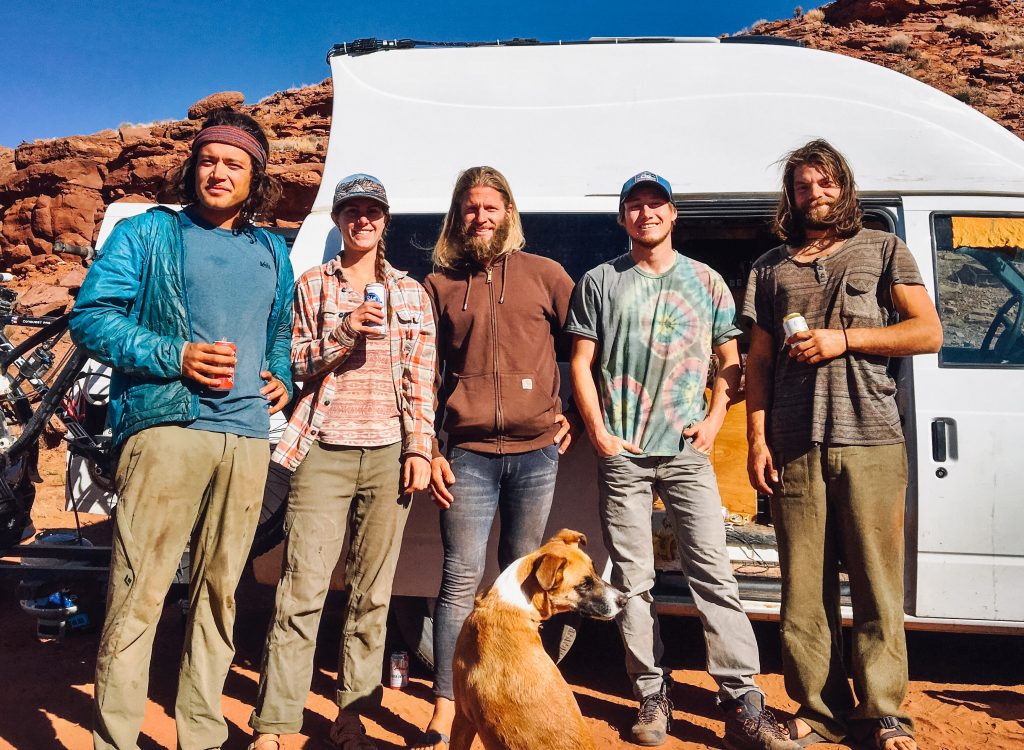
In some strange way, the freezing nights in the van, the hunger, the soreness felt from head to toe, the chapped lips, the sunburn and the dust-laden clothing, seemed only to emphasise every moment of content. It made the colours at dusk seem more vivid, the sense of community amongst us strong, every meal sweet, and the willingness to share, generous. It made our appetites to keep pushing ourselves on the rock day after day, insatiable. And this is exactly what hooked me. I was often left wondering how many places on the climber’s tick list can still boast of this sort of freedom anymore. The pioneering days now stories followers relish in the retelling. The 60’s era camp 4’s of the world are probably very few if not long gone. While Indian Creek isn’t exactly somewhere out of the spotlight, for somewhere as esteemed and loved, as world-class in its climbing and as unique in its style, it felt wild at every turn.
It was easy to be charmed by the dirt roads, the zero phone service, the community notice board that served as the best form of communication, and the droving of cattle still done on horseback. The petroglyphs there speak of a distant past, and although it’s not the same Indian Creek that the Navajo or Anasazi people knew, it is a place that continues to remain in its own version of time, slowly sewing its cryptobiotic crusts and hanging on to life.
It seemed everyone I met had a deep respect for the place. They understood it was something you needed to be mindful in caring for, something to be treated as a privilege. Whether it was climbers sticking strictly to one trail to protect the delicate crypto crust (that in many ways holds the desert together), packing out all their trash, exclusively using pit toilets, not climbing too close to ruins, or respecting crag closures due to bird nesting, it was a level of environmental awareness in climbing I hadn’t seen elsewhere. An admiration for the area’s fragility was always present.
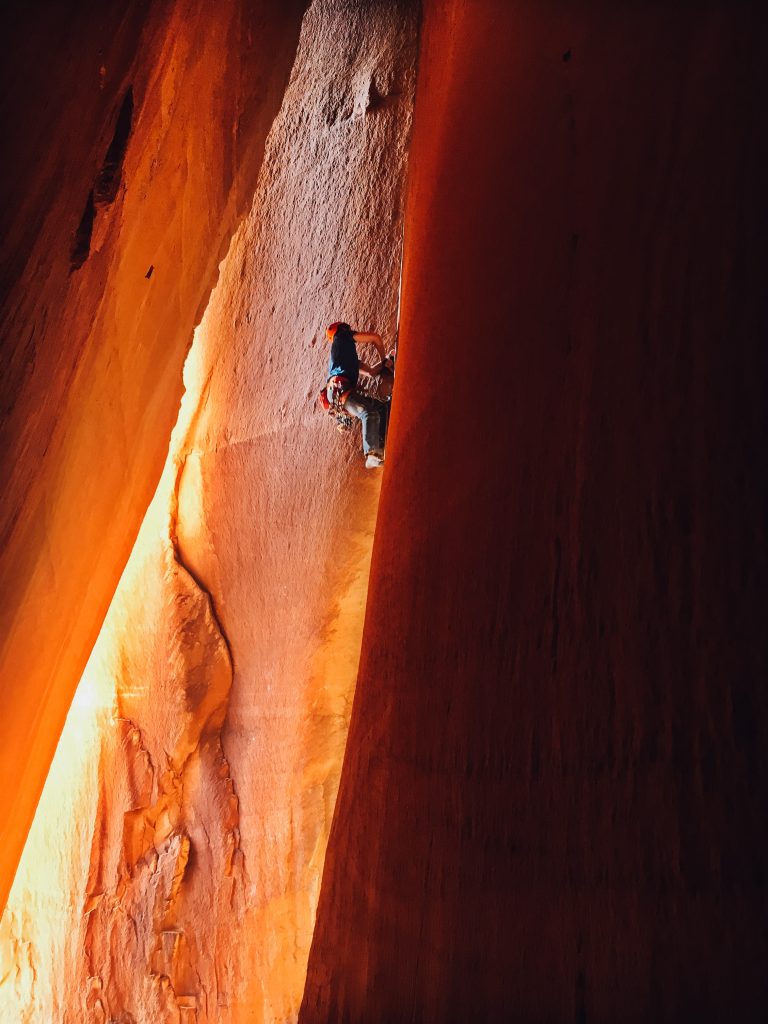
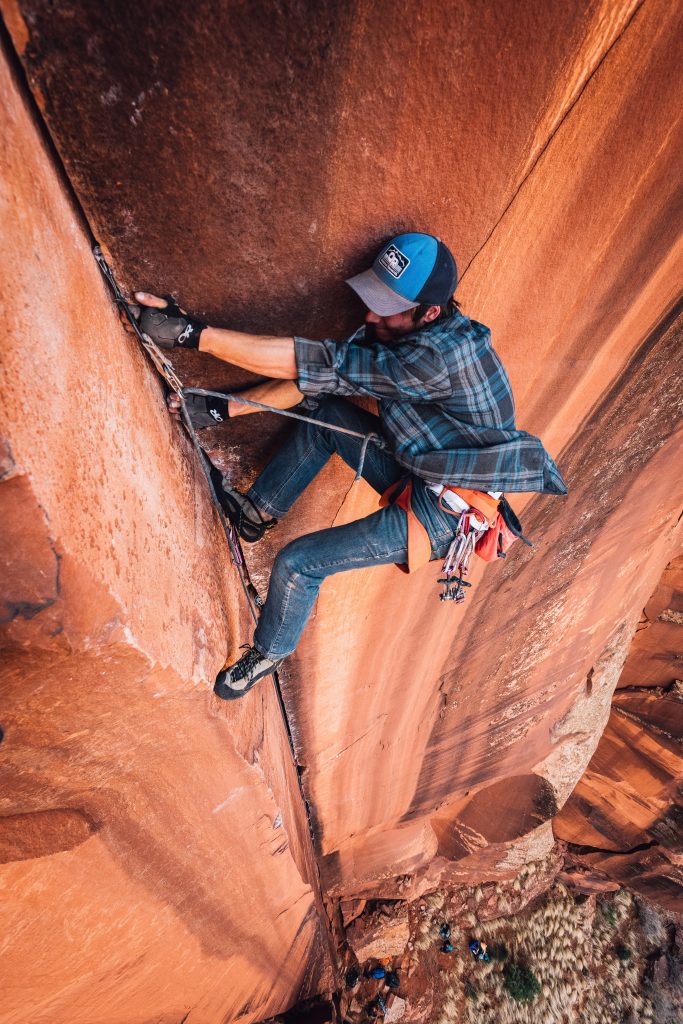
Angus Taylor smearing through the crux of ‘Technicolour’ 5.11 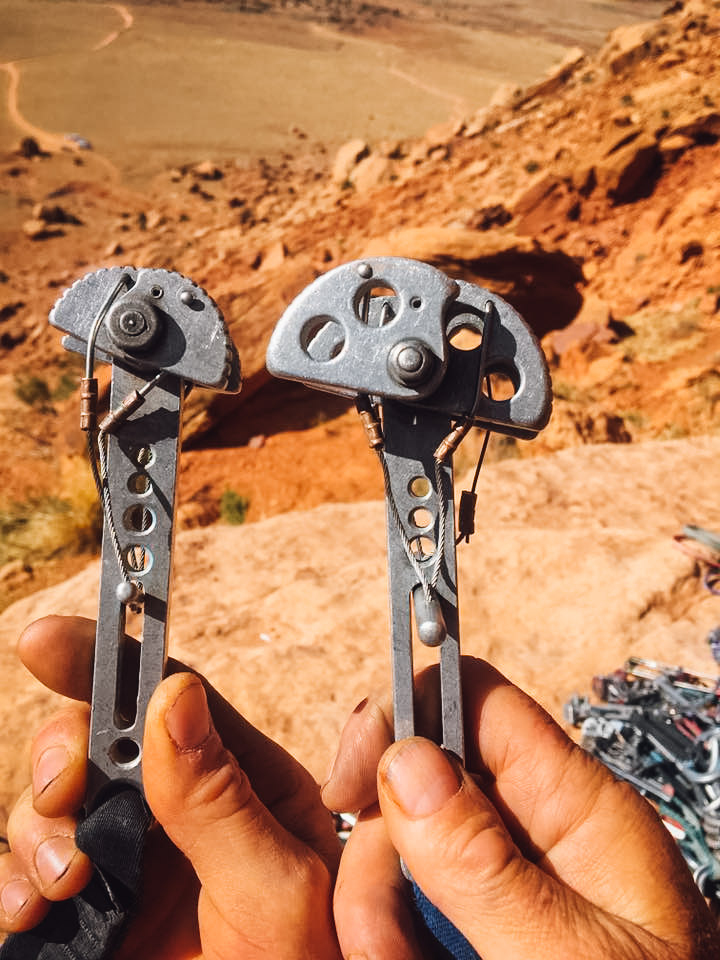
Cams from ‘yesteryear’ still proving their worth 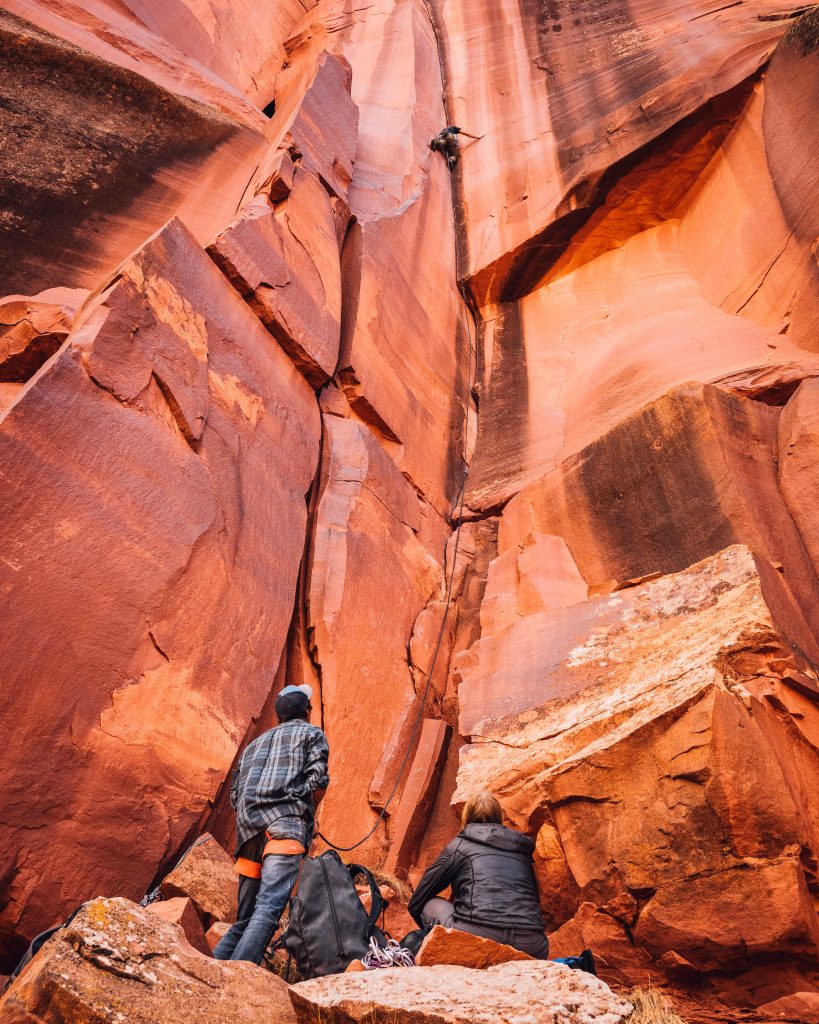
Getting racked up and ready for ‘Technicolour’ 5.11
One day I was introduced to a man nicknamed Q, aka James Q Martin, who had come along to take some shots of Mason Earl retro-onsighting a 5.12, going on 5.13+, called “Less than Zero”. I got talking to Q and he told us of a film he was making called “The Cowboy and The Climber”. He explained it was about a climber (himself) building a relationship with a local Indian Creek rancher and the trading of their respective crafts. Q would learn how to work the ranch, and the rancher would learn how to climb from Q. From what I understood, he wanted to create an understanding and an appreciation of how the land is used. Q is a well-known conservationist and has done incredible work with the community to keep areas like Indian Creek places we can come and enjoy as climbers. Talking with Q that day made me realise that a hard political battle was fought to keep this place open and accessible for recreational use. That educating people to have respect and duty of care for the land was integral to keeping places like this open for future generations. That fight is still going on.
As an Australian it made me appreciate the environments back home where we have generous levels of access to as climbers, and that in many ways these can be just as fragile. After meeting Q that day I was left with the feeling that we should be treating them with the same level of stewardship and responsibility.
From one moment to the next, the magnet that had been El Cap slowly began switching poles until my iron filling was eventually, immovably, buried in red dust. Sometimes spontaneity can take us like a strong current, changing the course of our plans so much that we wonder how we got there. Sometimes our original dreams get lost somewhere along the way but in the process, you realise the ones you weren’t aware you had. My dream wasn’t necessarily to say I climbed El Cap or to stand in a stupor in the meadow, ogling up at the valley giants, contemplating my insignificance. My dream was to learn new skills, throw myself into another world, roll with the punches, and ultimately, climb in an inspiring place. That dream came true in every sense.
One morning I drove into town, walked into the local gear trader store in Moab, and I sold my extra ropes. I used the money for food and water, fuelled up and drove straight back to The Creek, so I could continue to stuff my hands, feet, and limbs into the fractures of geologic entropy, and feel a part of something special.
